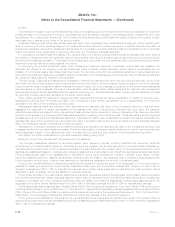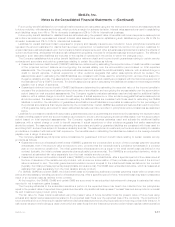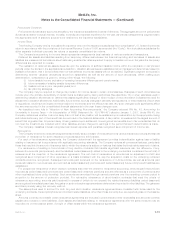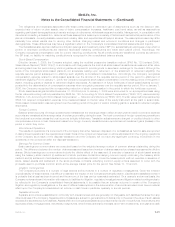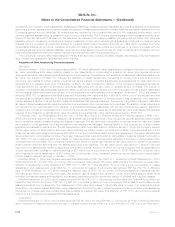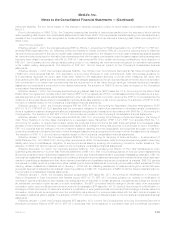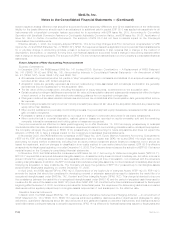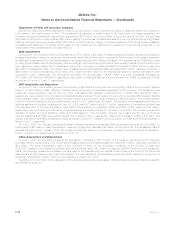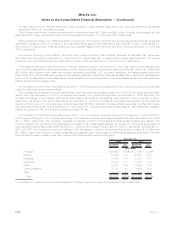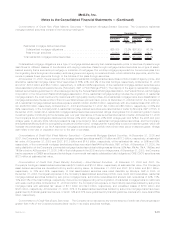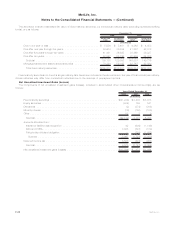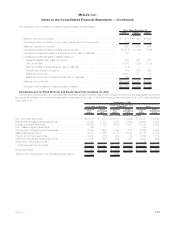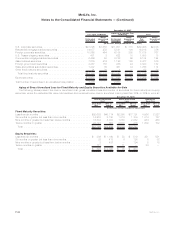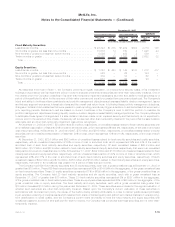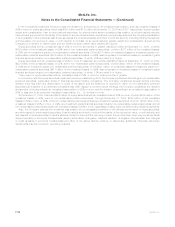MetLife 2008 Annual Report Download - page 149
Download and view the complete annual report
Please find page 149 of the 2008 MetLife annual report below. You can navigate through the pages in the report by either clicking on the pages listed below, or by using the keyword search tool below to find specific information within the annual report.feature results in a basis difference that should be accounted for as a temporary difference; and (ii) the establishment of the deferred tax
liability for the basis difference should result in an adjustment to additional paid-in capital. EITF 05-8 was applied retrospectively for all
instruments with a beneficial conversion feature accounted for in accordance with EITF Issue No. 98-5, Accounting for Convertible
Securities with Beneficial Conversion Features or Contingently Adjustable Conversion Ratios, and EITF Issue No. 00-27, Application of
Issue No. 98-5 to Certain Convertible Instruments. The adoption of EITF 05-8 did not have a material impact on the Company’s
consolidated financial statements.
Effective January 1, 2006, the Company adopted SFAS No. 154, Accounting Changes and Error Corrections, a replacement of APB
Opinion No. 20 and FASB Statement No. 3 (“SFAS 154”). SFAS 154 requires retrospective application to prior periods’ financial statements
for a voluntary change in accounting principle unless it is deemed impracticable. It also requires that a change in the method of
depreciation, amortization, or depletion for long-lived, non-financial assets be accounted for as a change in accounting estimate rather
than a change in accounting principle. The adoption of SFAS 154 did not have a material impact on the Company’s consolidated financial
statements.
Future Adoption of New Accounting Pronouncements
Business Combinations
In December 2007, the FASB issued SFAS No. 141 (revised 2007), Business Combinations — A Replacement of FASB Statement
No. 141 (“SFAS 141(r)”) and SFAS No. 160, Noncontrolling Interests in Consolidated Financial Statements — An Amendment of ARB
No. 51 (“SFAS 160”). Under SFAS 141(r) and SFAS 160:
• All business combinations (whether full, partial or “step” acquisitions) result in all assets and liabilities of an acquired business being
recorded at fair value, with limited exceptions.
• Acquisition costs are generally expensed as incurred; restructuring costs associated with a business combination are generally
expensed as incurred subsequent to the acquisition date.
• The fair value of the purchase price, including the issuance of equity securities, is determined on the acquisition date.
• Certain acquired contingent liabilities are recorded at fair value at the acquisition date and subsequently measured at either the higher
of such amount or the amount determined under existing guidance for non-acquired contingencies.
• Changes in deferred tax asset valuation allowances and income tax uncertainties after the acquisition date generally affect income
tax expense.
• Noncontrolling interests (formerly known as “minority interests”) are valued at fair value at the acquisition date and are presented as
equity rather than liabilities.
• When control is attained on previously noncontrolling interests, the previously held equity interests are remeasured at fair value and a
gain or loss is recognized.
• Purchases or sales of equity interests that do not result in a change in control are accounted for as equity transactions.
• When control is lost in a partial disposition, realized gains or losses are recorded on equity ownership sold and the remaining
ownership interest is remeasured and holding gains or losses are recognized.
The pronouncements are effective for fiscal years beginning on or after December 15, 2008 and apply prospectively to business
combinations after that date. Presentation and disclosure requirements related to noncontrolling interests must be retrospectively applied.
The Company will apply the guidance in SFAS 141(r) prospectively on its accounting for future acquisitions and does not expect the
adoption of SFAS 160 to have a material impact on the Company’s consolidated financial statements.
In November 2008, the FASB ratified the consensus on EITF Issue No. 08-6, Equity Method Investment Accounting Considerations
(“EITF 08-6”). EITF 08-6 addresses a number of issues associated with the impact that SFAS 141(r) and SFAS 160 might have on the
accounting for equity method investments, including how an equity method investment should initially be measured, how it should be
tested for impairment, and how changes in classification from equity method to cost method should be treated. EITF 08-6 is effective
prospectively for fiscal years beginning on or after December 15, 2008. The Company does not expect the adoption of EITF 08-6 to have a
material impact on the Company’s consolidated financial statements.
In November 2008, the FASB ratified the consensus on EITF Issue No. 08-7, Accounting for Defensive Intangible Assets (“EITF 08-7”).
EITF 08-7 requires that an acquired defensive intangible asset (i.e., an asset an entity does not intend to actively use, but rather, intends to
prevent others from using) be accounted for as a separate unit of accounting at time of acquisition, not combined with the acquirer’s
existing intangible assets. In addition, the EITF concludes that a defensive intangible asset may not be considered immediately abandoned
following its acquisition or have indefinite life. The Company will apply the guidance of EITF 08-7 prospectively to its intangible assets
acquired after fiscal years beginning on or after December 15, 2008.
In April 2008, the FASB issued FSP No. FAS 142-3, Determination of the Useful Life of Intangible Assets (“FSP 142-3”). FSP 142-3
amends the factors that should be considered in developing renewal or extension assumptions used to determine the useful life of a
recognized intangible asset under SFAS No. 142, Goodwill and Other Intangible Assets (“SFAS 142”). This change is intended to improve
the consistency between the useful life of a recognized intangible asset under SFAS 142 and the period of expected cash flows used to
measure the fair value of the asset under SFAS 141(r) and other GAAP. FSP 142-3 is effective for financial statements issued for fiscal years
beginning after December 15, 2008, and interim periods within those fiscal years. The requirement for determining useful lives and related
disclosures will be applied prospectively to intangible assets acquired as of, and subsequent to, the effective date.
Derivative Financial Instruments
In March 2008, the FASB issued SFAS No. 161, Disclosures about Derivative Instruments and Hedging Activities —An Amendment of
FASB Statement No. 133 (“SFAS 161”). SFAS 161 requires enhanced qualitative disclosures about objectives and strategies for using
derivatives, quantitative disclosures about fair value amounts of and gains and losses on derivative instruments, and disclosures about
credit-risk-related contingent features in derivative agreements. SFAS 161 is effective for financial statements issued for fiscal years and
F-26 MetLife, Inc.
MetLife, Inc.
Notes to the Consolidated Financial Statements — (Continued)


